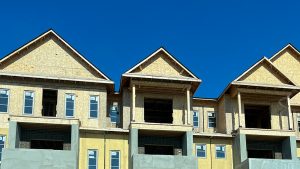A study is underway to look at how new houses constructed in Nelson, B.C., stack up when it comes to embodied carbon.
City building inspector Sam Ellison says the idea is to look at all the materials used in building the homes, including those built to BC Energy STEP Code requirements, to determine the real carbon footprint.
The STEP Code calculates heat loss from new buildings and attempts to reduce energy loss overall by promoting advanced ways of constructing. However, it doesn’t take embodied carbon into account.
The data will be used to help the city make better decisions in future.
“What’s become apparent is that some of the building materials that really work well for energy efficiency like Styrofoam are very high in embodied carbon,” says Ellison. “When you take one of these ICF foundations which have become very popular for good reason, it’s easy, and achieves very high R-values, but it ends up containing a lot of Styrofoam, a lot of concrete, and a lot of steel, which are all real bad offenders.”
Embodied carbon is the total greenhouse gases (GHGs) emitted to the atmosphere from harvesting, manufacturing and transporting building materials. By some estimates, as much as 11 per cent of global emissions of GHGs come from manufacturing building materials used in construction. On a per-building basis, it’s not unusual to have more than 500 kilograms of emissions per square metre of building.
Mining steel, for example, and refining, producing and transporting concrete are bad offenders compared to building with wood, which can be harvested locally, because the materials have high embedded carbon scores and add to GHGs.
“There’s a lot of more readily available materials that have a lot lower embodied carbon and achieve the same or similar results,” says Ellison.
The city is taking several houses already built to the BC Energy STEP Code and will calculate the carbon footprints of them, including the embodied carbon, to get a true picture. Another calculation will be done to figure out what the carbon footprint would have been if different materials were used in construction.
The idea came up when Ellison went to city council with a proposal to move to step three of the STEP code. He notified council he was reluctant to move to a higher step until looking further into embodied carbon.
“I made a commitment to council that I wouldn’t recommend higher steps than three unless we did more investigation on what is being built here, what could be built, and how the houses being built in Nelson today rate relative to embodied carbon.”
Michele Deluca of 3West Building Consultants is collecting the data and, using a calculator developed by Builders for Climate Action, will figure out the embodied carbon of recently-built or under-construction energy-efficient homes and compare it to what it would have been had different materials been used.
In the end, Ellison will have a report to take back to city council.
“It’s something concrete that I can take back to council and say, ‘In our town, this is what’s happening.’”
The energy-efficiency information on recent builds is readily available, says Ellison, because builders had to provide compliance reports to have their houses energy-modelled in the first stage of the STEP Code. The information includes details about the types of building materials used and R-values of insulation.
A report will be presented to Nelson City Council within the next few weeks.
Ellison says the city is looking into the issue on its own and does not have any plans to tell builders what types of construction materials they should use, as municipalities don’t have the right to do so.
“Without special permission from the province, we can’t make people build with different kinds of materials.”
The step code has five levels and a series of measurable energy-efficiency requirements that builders must meet in communities that adopt it. The province wants all new buildings to reach a net-zero energy efficiency by 2032.
The municipality can adopt stages of the step code earlier to make people make their houses more energy efficient, but it can not make them build with wood instead of Styrofoam, for example, says Ellison.
“Our goal is to try to get a better idea of what’s actually being built, how much we can improve and then try to incentivize, in different ways, people to consider this when they build.”
Ellison says builders in the Nelson area have embraced the concept of making new homes more energy efficient although they have questions to be answered about cost-efficiency. He’d contacted about 80 per cent of new homebuilders about moving to step three and they all wrote letters of support.
“We’ve got a pretty progressive group around here and a good portion of them are aware or somewhat aware of what embodied carbon is about and seem to be interested in making houses more energy efficient and less polluting.”











Recent Comments
comments for this post are closed